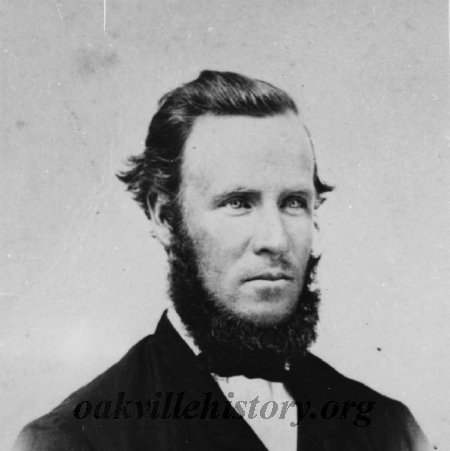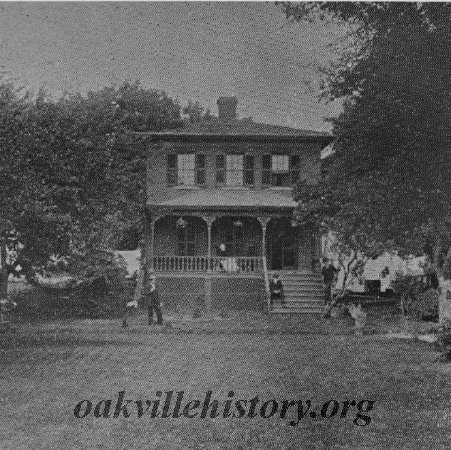Address:
279 Lawson Street - Mariner's Home
Summary:
This house was known as "Mariner's Home" and was first owned by Captain Robert Wilson. It was built in 1862.
Property Details:
Robert Wilson and his two brothers, William and George came early to Oakville. Their mother brought her ten children to Canada in 1817 from Ireland after the death of her husband.
In the 1830s, Robert was the first master of the second schooner built at Oakville, The Lady Colborne. In 1832 Robert bought a lot at the corner of Navy and King Streets. The house he built there still stands. He bought this property in 1837 and built the house in 1862. It became known as Mariners' Home because of his custom of bringing ill and homeless sailors to live with him. This is the same Captain Robert Wilson who helped blacks to escape across the Lake and now has a local school named after him. Some of those he assisted never failed to visit him on Emancipation Day when they gathered from this part of the province for a picnic in Oakville. He was also captain of the Baltic, built at Wellington Square in 1854, and once sailed to Liverpool with flour from the Chisholm brothers' mill.
Another fact about Robert is that he *possibly* stole a cutlass from England's Royal Guard (marked with the cipher of King George); the cutlass is still retained by Robert Wilson's descendants.
His granddaughter provided a description of this house:
"The house was set well back from the street. A wide flower-bordered path covered at one place by a grape arbour led from the gate on Dundas Street [Trafalgar Road] up to a number of steps to the front door. This floor of the house contained a hall, parlour, sitting room and bedroom. From the sitting room, which was in the south east corner, a stairway went down into a large room right across the front half of the house. This was a combination kitchen and family dining room (the sitting room was used as a dining room on special occasions). While it was in the basement yet the windows were well above ground level. However in a very rainy season it would flood. We have recollections of the fun of running on boards from chair to chair to reach supplies in the cupboards. At the back of the room a high step took one into a hall of which were a pantry and a cellar containing bins for apples, vegetables and coal. A door in the south wall led to a short stairway up into a summer kitchen and washhouse built on the side of the house.
"From the front hall a long staircase went to the upstairs containing three bedrooms and a small store room. In the ceiling of the hall was a trap door reached by a ladder leading to the attic. Another trap door opened onto the roof. As some of the branches of a large cherry tree extended over the roof a picker secured by a rope could climb out on the roof through these trap doors.
"The house was heated by three stoves, one each in the kitchen, sitting room and parlour. At the rear of the house was a well noted for the purity of its water. Beyond the well lay a woodhouse, then a barn, which housed a cow, then a henhouse and pigsty. The northwest section of the lot was covered by an orchard; the northeast by a vegetable garden. The lot was a miniature farm. It needed to be for besides raising their own family of five, our grandparents took in four orphans and grandfather frequently brought home sick or homeless sailors in the winter. This house was truly given to dispensing hospitality, kindness and happiness. No one left without a meal or a parcel of garden produce. One of the chief social events was Capt. Robert and grandmother's golden wedding in 1881. When the house sold the price was $1700. This was in the 1890s"
In the 1830s, Robert was the first master of the second schooner built at Oakville, The Lady Colborne. In 1832 Robert bought a lot at the corner of Navy and King Streets. The house he built there still stands. He bought this property in 1837 and built the house in 1862. It became known as Mariners' Home because of his custom of bringing ill and homeless sailors to live with him. This is the same Captain Robert Wilson who helped blacks to escape across the Lake and now has a local school named after him. Some of those he assisted never failed to visit him on Emancipation Day when they gathered from this part of the province for a picnic in Oakville. He was also captain of the Baltic, built at Wellington Square in 1854, and once sailed to Liverpool with flour from the Chisholm brothers' mill.
Another fact about Robert is that he *possibly* stole a cutlass from England's Royal Guard (marked with the cipher of King George); the cutlass is still retained by Robert Wilson's descendants.
His granddaughter provided a description of this house:
"The house was set well back from the street. A wide flower-bordered path covered at one place by a grape arbour led from the gate on Dundas Street [Trafalgar Road] up to a number of steps to the front door. This floor of the house contained a hall, parlour, sitting room and bedroom. From the sitting room, which was in the south east corner, a stairway went down into a large room right across the front half of the house. This was a combination kitchen and family dining room (the sitting room was used as a dining room on special occasions). While it was in the basement yet the windows were well above ground level. However in a very rainy season it would flood. We have recollections of the fun of running on boards from chair to chair to reach supplies in the cupboards. At the back of the room a high step took one into a hall of which were a pantry and a cellar containing bins for apples, vegetables and coal. A door in the south wall led to a short stairway up into a summer kitchen and washhouse built on the side of the house.
"From the front hall a long staircase went to the upstairs containing three bedrooms and a small store room. In the ceiling of the hall was a trap door reached by a ladder leading to the attic. Another trap door opened onto the roof. As some of the branches of a large cherry tree extended over the roof a picker secured by a rope could climb out on the roof through these trap doors.
"The house was heated by three stoves, one each in the kitchen, sitting room and parlour. At the rear of the house was a well noted for the purity of its water. Beyond the well lay a woodhouse, then a barn, which housed a cow, then a henhouse and pigsty. The northwest section of the lot was covered by an orchard; the northeast by a vegetable garden. The lot was a miniature farm. It needed to be for besides raising their own family of five, our grandparents took in four orphans and grandfather frequently brought home sick or homeless sailors in the winter. This house was truly given to dispensing hospitality, kindness and happiness. No one left without a meal or a parcel of garden produce. One of the chief social events was Capt. Robert and grandmother's golden wedding in 1881. When the house sold the price was $1700. This was in the 1890s"






